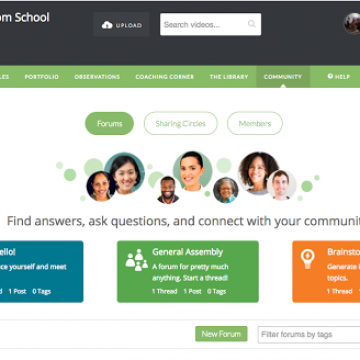Your school is using the Danielson Framework Rubric in conjunction with teacher observations and professional development coaching.
It’s a complex framework that requires some time to learn and implement.
But with some training and guidance, the Danielson Rubric can be used effectively to improve teachers’ performance in the classroom.
It’s not as difficult as it may seem.
In this guide, you will understand how the Danielson Framework for Teaching Rubric works, learn about the elements that make up the Danielson Framework, and receive actionable advice on how to use it effectively for teacher observation and professional development.
Table of Contents
- What Is the Danielson Framework Rubric?
- What Are the Four Domains of Danielson?
- Using the Danielson Framework Rubric for Professional Development
What Is the Danielson Framework Rubric?
The Danielson Framework Rubric is a system used to measure and improve the quality of teaching.
The rubric provides a framework for assessing teacher practice by measuring four domains:
- Planning and preparation
- Instruction
- Assessment
- Professionalism
Teachers use the rubric to self-reflect on their practice and identify strengths and areas for growth.
A History of the Development of the Danielson Framework Rubric
Charlotte Danielson developed the Danielson Framework Rubric in the 1990s after she had been given the responsibility to understand what effective teaching is.
As a result, Danielson wrote the book The Danielson Framework for Teaching Rubric, which described and outlined a research-based definition of:
- Effective teaching
- Research-based teaching standards
States originally used the Danielson Rubric to license teachers and other leaders, but the components in the rubric quickly became the standard for evaluating and supporting good teaching in the classroom.
Until this point in time, there were no documented teaching standards that were proposed to be effective.
What Is the Danielson Framework Rubric Used for?
The Danielson Framework Rubric is a system used to:
- Guide teacher observation and coaching
- Help identify areas of growth for teachers
- Measure and improve teacher effectiveness
- Evaluate the impact of professional development
- Provide a common language and understanding of teaching practice
Today’s educators have become increasingly sophisticated in their ability to identify and understand teaching standards.
However, it’s still difficult for administrators and educators to agree on what demonstrates effective teaching.
The Danielson Framework for Teaching Rubric helped bridge that gap by providing a research-based definition of effective teaching.
Has the Danielson Framework Rubric Been Updated?
As an educator, it can be difficult keeping up with the latest education trends.
Although Danielson’s Rubric was created in the early 1990s, the rubric has been revised and updated over the years to meet the changing standards in education.
Every few years, the information that’s already known about effective teaching is examined to see if anything new has been discovered.
New processes or findings can lead to changes in the standards by which good teaching “looks and feels” or is measured. Generally, the qualities that make up the standards of good teaching have remained relatively stable for the last 20 years.
One notable exception is the way technology is both defined and used in the classroom, as tech has transformed dramatically in the last decade.
Monumental shifts like these in education are the kind reflected in the latest editions of the Danielson Framework Rubric.
What Are the Four Domains of Danielson?
The Danielson Framework Rubric is comprised of four domains:
- Planning and Preparation
- Classroom Environment
- Instruction
- Professional Responsibilities
Each domain is rated on a scale of 1-4, with 4 being the highest rating.
#1: Planning and Preparation
The first domain of the Danielson Framework involves the process of planning the content and lessons that the teacher will deliver to their students throughout the year.
It assesses and supports the teacher’s ability to organize and manage student learning objectives. The Planning and Preparation domain works to enable a teacher to demonstrate knowledge of:
- Pedagogy and content
- Understanding students
- Instructional goals
- Effective resources
- Instructional design
- Student assessment
#2: The Classroom Environment
This domain articulates a standard for effectively cultivating a balanced classroom environment. According to the framework, a healthy teacher-cultivated educational environment involves:
- A culture of learning
- Managing student conduct
- Common respect for one another
- Classroom management and organization
The classroom environment created by a teacher is very important to the successful delivery of teaching and learning. It is often considered an essential building block of classroom learning.
#3: Instruction
Domain 3 includes the effective use of research-based teaching strategies that engage students in instructional learning.
These strategies include:
- Communicating accurately and clearly
- Providing constructive feedback to students
- Using engaging learning strategies with students
- Implementing discussion and question techniques
- Demonstrating responsiveness and flexibility with instruction
#4: Professional Responsibilities
Educators know that the responsibilities they carry go beyond the classroom walls. Not only do teachers bear the responsibility to effectively deliver student learning and instruction, but in order to do that well, educators are also expected to maintain a standard of professionalism in other areas of the profession.
Some of these responsibilities include:
- Self-reflection of teaching
- Maintaining accurate records
- Demonstrating patience and professionalism
- Communicating with students’ families
- Contributing to the school and district
- Professional Development
Educators who demonstrate these competencies bring a high level of value to their classrooms, teams, districts, and communities.
Using the Danielson Framework Rubric for Professional Development
Danielson’s Rubric is a widely used and highly regarded framework for teacher observation. Many districts and schools use the rubric for teacher observation and development but struggle with using it effectively.
Let’s look at how to use the Danielson Framework for teacher observation.
How to Effectively Utilize the Danielson Framework Rubric Alongside TORSH Talent
The Danielson Framework Rubric is a needs-based tool that can be used to:
- Provide feedback to teachers
- Identify professional development needs; and
- Monitor teacher effectiveness school and district-wide
Whether you have been in the classroom for one year or ten years, the Danielson Framework Rubric provides you with feedback that is specific to your teaching practice.
TORSH Talent is a tool that can utilize the Danielson Framework Rubric to support districts in professional development. TORSH Talent connects educational coaches and teachers with the tools to successfully address any behavior or academic challenges in the classroom.
The TORSH Talent software can support any framework or set of standards a district chooses. TORSH Talent is not a teacher evaluation tool. Instead, the primary focus is to provide observation and coaching solutions to support professional development through our unique, collaborative approach.
If you would like to have a demonstration of the TORSH Talent software, our most comprehensive platform for all your professional learning needs, please contact us.
Coaching
The Danielson Framework rubric can be used to aid in professional development through coaching. Coaches can benefit from a framework that guides, measures, and helps improve overall teacher effectiveness.
The Danielson Framework Rubric is one such tool that has been widely accepted as reliable and valid among educators and coaches. It can be used as a starting point in a coaching relationship.
For example, if a first-year teacher meets with a coach for the first time, the coach could ask:
- “What’s going well so far?”; or
- “What keeps you up at night?”
The teacher may respond by sharing that they feel good about their lesson planning, but they can’t get the students to behave in the classroom.
A coach will recognize that this is a good starting point and suggest focusing on managing student behavior by referring to Danielson’s Rubric.
The teacher may also send video clips of scenarios in the classroom when students show appropriate behavior versus inappropriate behavior in the classroom.
When teachers and coaches are talking about these things, they can use the Danielson model to have a richer conversation using a common language of teaching standards.
Video Observation
When utilizing the Danielson Framework Rubric, video observation of teachers can help provide a comprehensive understanding of their teaching practices.
To effectively use video observation with Danielson’s Rubric, it is important to understand the different components of the rubric.
The following examples will illustrate how the Danielson Framework Rubric with video observation can help to identify strengths and areas for improvement for individual teachers.
- Video 1: A teacher provides multiple examples of how to solve a problem. Using the Danielson Framework Rubric with video observation can help to identify areas where the teacher is providing clear and concise instruction.
- Video 2: A teacher uses visuals (e.g., whiteboards, 3-D objects, etc.) to explain concepts. Using the Danielson Framework Rubric with video observation can help to identify areas where the teacher is using visuals effectively to help students understand concepts.
- Video 3: A teacher facilitates a classroom discussion to check for understanding. Using the Danielson Framework Rubric with video observation can help to identify areas where the teacher is engaging in effective question asking and discussions with students.
To make the best use of video observations consider using Danielson’s Rubric accompanied by a collection of classroom data to get a more holistic view of a teacher’s professional practice.
TORSH Talent tools allow you to collaborate with colleagues, monitor progress, and present evidence. The time-synchronized commenting tool enables you to make annotations of video observations.
Self-Assessments
Educators know how important it is to reflect continuously on their practice to grow and improve.
Seasoned teachers can use the rubric to assess their teaching and identify areas for growth.
While the rubric can be used independently, it is most effective when used in collaboration with a peer or supervisor.
For example, if a coach is working with a board-certified teacher in their 25th year, an effective approach to coaching would include:
- Encouraging the teacher to do a self-assessment with the rubric
- Finding out what their professional goals are for the school year
- Helping them to make a plan for achieving their self-identified goals
On the other hand, new teachers may need more guidance and coaching to identify professional development goals. In which case, the rubric can be utilized to build a strong foundation of effective teaching.
With the TORSH Talent software, educators can also leverage a tool called Insights which aids in the self-assessment process.
Setting District Goals
The Danielson Framework Rubric is a great tool for setting district goals. It can help determine where your district stands and what areas need improvement. The rubric can help create specific goals and track progress.
Because the Danielson Rubric brings common language to different goals and objectives in education, it can be:
- Used by administrators, teachers, and other district staff
- Easily adapted to meet the specific needs of individual districts; and
- A basis for setting expectations from the district team in terms of student achievement
The rubric provides a comprehensive way to assess district strengths and weaknesses to identify specific goals to improve student achievement.
For example, a district may compile data from teacher observations through the lens of the Danielson Framework Rubric and see the lowest score across the district was in the area of questioning.
As a result, the district could see a goal to growing in this area by providing support for teachers in this area through:
- Teacher observation
- Teacher coaching; and
- Professional development
Danielson’s Rubric is responsive to the needs of the setting — whether it’s teacher, school, or district-focused.
By using the TORSH Talent tool, you can make a web library of multimedia content that is unique to your school district.
You can compile a series of videos, audio, documents, or presentations for your district to highlight and share progress monitoring with appropriate administrators, coaches, and teachers.
Contact us to request a demonstration of TORSH Talent software — the most comprehensive platform for all of your professional learning needs.




